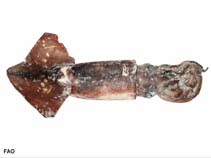Advertisement
Dosidicus gigas (D'Orbigny, 1835)
Jumbo flying squid| Native range | All suitable habitat | Point map | Year 2050 |

|
| This map was computer-generated and has not yet been reviewed. |
| Dosidicus gigas AquaMaps Data sources: GBIF OBIS |
United States (contiguous states) country information
Common names:
[No common name]
Occurrence: native
Salinity: marine
Abundance: | Ref:
Importance: | Ref:
Aquaculture: never/rarely | Ref:
Regulations: no regulations | Ref:
Uses: no uses
Comments: Known from western United States to Mexico (Ref. 1667).
National Checklist:
Country Information: https://www.cia.gov/library/publications/resources/the-world-factbook/geos/us.html
National Fisheries Authority: http://www.nmfs.gov
Occurrences: Occurrences Point map
Main Ref: Turgeon, D.D., J.F. Quinn Jr., A.E. Bogan, E.V. Coan, F.G. Hochberg, W.G. Lyons, P.M. Mikkelsen, R.J. Neves, C.F.E. Roper, G. Rosenberg, B. Roth, A. Scheltema, F.G. Thompson, M. Vecchione and J.D. Willams, 1998
National Database:
Occurrence: native
Salinity: marine
Abundance: | Ref:
Importance: | Ref:
Aquaculture: never/rarely | Ref:
Regulations: no regulations | Ref:
Uses: no uses
Comments: Known from western United States to Mexico (Ref. 1667).
National Checklist:
Country Information: https://www.cia.gov/library/publications/resources/the-world-factbook/geos/us.html
National Fisheries Authority: http://www.nmfs.gov
Occurrences: Occurrences Point map
Main Ref: Turgeon, D.D., J.F. Quinn Jr., A.E. Bogan, E.V. Coan, F.G. Hochberg, W.G. Lyons, P.M. Mikkelsen, R.J. Neves, C.F.E. Roper, G. Rosenberg, B. Roth, A. Scheltema, F.G. Thompson, M. Vecchione and J.D. Willams, 1998
National Database:
Common names from other countries
Classification / Names Populärnamn | synonymer | Catalog of Fishes (gen., sp.) | ITIS | CoL | WoRMS
Environment: milieu / climate zone / depth range / distribution range Ekologi
Pelagiska; djupintervall 0 - 1200 m (Ref. 1982). Tropical; 4°C - 32°C (Ref. 1982), preferred 26°C (Ref. 107945); 60°N - 53°S, 169°W - 70°W
Distribution Länder | FAO områden | Ekosystem | Förekomster | Utplanteringar
Eastern Pacific. From south of Bering Strait to Gulf of Alaska, east to Gulf of California and south to Chile. Tropical to boreal.
Length at first maturity / Size / Weight / Age
Maturity: Lm 29.7 range ? - ? cm Max length : 400 cm TL hane/ej könsbestämd; (Ref. 275); common length : 80.0 cm TL hane/ej könsbestämd; (Ref. 275); publicerad maxvikt: 3.0 kg (Ref. 275)
Common total length: 50 to 80 cm. Caught by jigs (Ref. 275). Maximum total length is 4 m. Common length is about 50 to 80cm (Ref. 3722). Inhabits offshore areas of continental shelves from surface to depths of at least 1200 m. Found over the shelves and near shores during feeding. Adults undergo diel vertical migrations with a night lift to the 0-200 m water layer, going down at daytime to depths of 800-1,000 m and deeper (Ref. 2130). Upper temperature limits range from 30 to 32°C in equatorial areas, while deeper water temperature limits are not less than 4 to 4.5°C. Active predator, feeds actively at dusk and dawn. Commonly feeds on copepods, hyperiid amphipods, euphausiids, pelagic shrimps and red crabs (Pleuroncodes planipes), heteropod mollusks, squid, octopods and various fish. Exhibits cannibalism, but only on juvenile squids (Ref. 1982).
Life cycle and mating behavior Könsmognad | Reproduktion | Lek | Eggs | Fecundity | Larvae
Members of the class Cephalopoda are gonochoric. Male and female adults usually die shortly after spawning and brooding, respectively. Mating behavior: Males perform various displays to attract potential females for copulation. During copulation, male grasp the female and inserts the hectocotylus into the female's mantle cavity where fertilization usually occurs. Life cycle: Embryos hatch into planktonic stage and live for some time before they grow larger and take up a benthic existence as adults.
Main reference
referenser | Koordinator | Medarbetare
Roper, C.F.E., M.J. Sweeney and C.E. Nauen. 1984. (Ref. 275)
IUCN Red List Status
(Ref. 130435: Version 2024-2)
Data deficient (DD) ; Date assessed: 05 May 2010
CITES status (Ref. 108899)
Not Evaluated
CMS (Ref. 116361)
Not Evaluated
Human uses
Fiskeri: kommersiell
FAO - fiskeri: landings, species profile | FishSource | Sea Around Us
Verktyg
Ytterligare information
Internet-källor
BHL | BOLD Systems | CISTI | DiscoverLife | FAO(fiskeri: species profile; publication : search) | GenBank (genome, nucleotide) | GloBI | Gomexsi | Google Books | Google Scholar | Google | PubMed | Tree of Life | Wikipedia (Go, sök) | Zoological Record
Estimates based on models
Preferred temperature
(Ref. 115969): 7.8 - 13.8, mean 10.8 (based on 88 cells).
Resiliens
(Ref. 69278)
Hög, lägsta populationsfördubblingstid mindre än 15 månader (K=0.17-1.2; tm=0.53).
Prior r = 1.19, 95% CL = 0.79 - 1.79, Based on 2 data-limited stock assessments.




